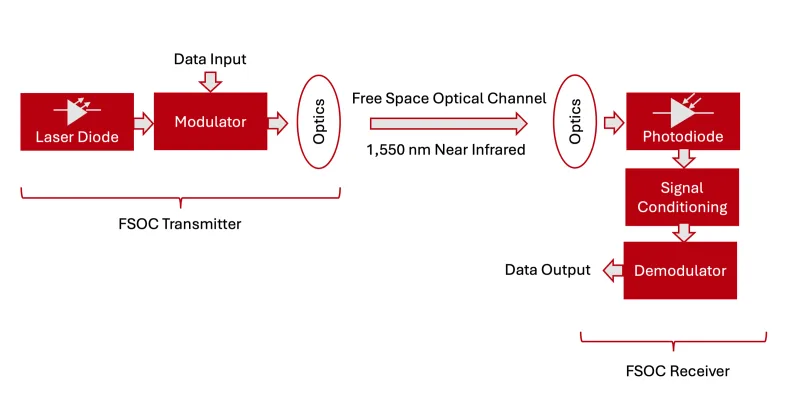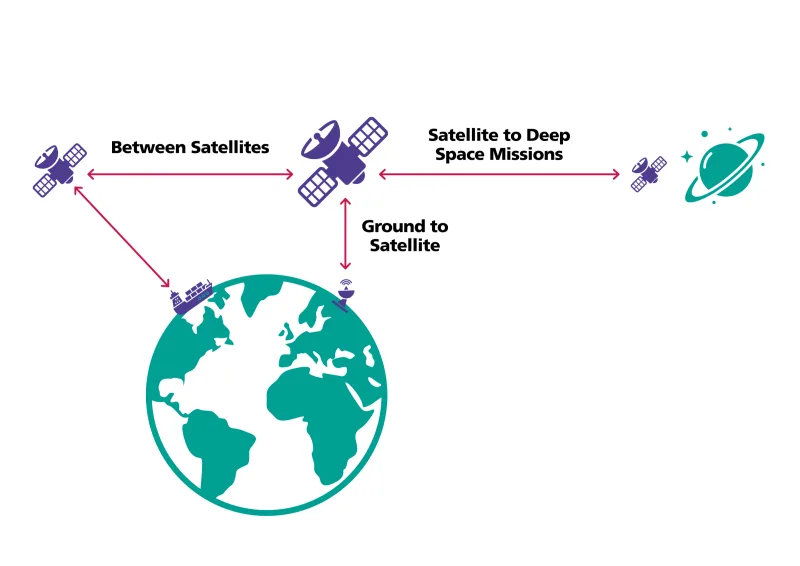Free-Space Optical Communication: High Data Rate Connectivity from the Ground Up
Wireless communication has witnessed remarkable advancements in recent years, driven by a growing demand for higher data rates and capacity. As traditional radio frequency (RF) and microwave technologies struggle to keep pace with these growing requirements, free-space optical communication (FSOC) has emerged as a frontrunner, to address bandwidth limitations and last-mile connectivity challenges.
Understanding FSOC
FSOC operates on a straightforward principle: the transmission of modulated laser light through the air between a transmitter and receiver. This process involves lenses or parabolic mirrors to narrow and project the light towards the receiver where it is captured and focused onto an optical detector, typically a semiconductor photodiode. Here, the optical signal is converted into an electrical one for processing.

The technology leverages the visible and infrared (IR) light spectrum, in contrast to the radio frequency spectrum used by most wireless systems. This offers significant benefits, not least a vast unlicensed spectrum in which FSOC systems typically operate at wavelengths between 700 nm and 1600 nm, called near infrared.
Compared with wireless systems, FSOC can operate with lower power consumption, reducing cost and environmental impact. One reason is that narrow FSOC beams are more focused than wireless emissions, boosting the received signal strength and mitigating the need for high-power transmitters. What’s more, antenna designs are more compact using optics compared to RF. This can reduce installation space constraints and aesthetic impact, which can be important where there is local sensitivity towards their presence. Where the security of communications is an important consideration, FSOC systems may be preferred over wireless links because eavesdropping on optical links is technically challenging, and the risk of interception is relatively low.
A further benefit of FSOC is that wireless channels are either regulated or where not regulated, already densely populated. FSOC needs no license and due to its narrow transmission angle is less susceptible to interference from other signals.
The market for FSOC technology
Most analysts predict strong growth for the FSOC market driven by growing demand for LTE networks, the desire for an alternative to RF technology, the requirement for more secure high-speed communications, and addressing the challenges of last mile connectivity in optical networks, not least for fiber-to-the-premises (FTTP) and fiber-to-the-home (FTTH) installations.
VynZ Research’s report “Global Free Space Optics Market – Analysis and Forecast (2025-2030)”, forecasts a 30% compound annual growth rate (CAGR) for FSOC between 2025 and 2030, the global market, led by the US, reaching a value of 1.9 USD billion, up from just 0.55 USD billion in 2023.
This positive forecast is despite the acknowledged challenges of environmental interference and installation capital costs. The report highlights the need for devices with greater photon efficiency to mitigate some factors that could limit growth.
Applications for FSOC
In terrestrial applications, FSOC promises to be a cost-effective alternative to fiber optic systems for high-speed connections in multi-point scenarios, such as large organizations or remote areas. Furthermore, its high capacity and low latency make it a promising technology for 5G backhaul links. Some hybrid systems are evolving that combine RF and FSOC technologies to provide greater reliability by adapting to varying weather conditions and interference levels.
The space sector has recognized the potential of FSOC technology, particularly in satellite communications. The technology can be used for both earth-to-satellite and satellite-to-satellite communication. In the latter scenario, its performance is particularly impressive because atmospheric factors do not impede performance and in space, data rates can scale into the terabit-per-second (Tbps) range. As a result, the reduced weight, lower power consumption, and higher data rates of FSOC make it a particularly attractive alternative to RF systems in these applications.

Atmospheric conditions have until recently been a limiting factor in distance and bandwidth capabilities in FSOC but techniques to mitigate these, such as adaptive optics, are now employed. These result in improved data rates for a given bit error rate (BER).
The first high-capacity space-to-ground laser communication system was installed on the Bartolomeo platform of the International Space Station (ISS) as part of a collaboration between Airbus Defence and Space, the Institute of Communications and Navigation of DLR (German Aerospace Center) and Tesat-Spacecom GmbH & Co. KG. The 2018 project, called OSIRIS, was designed to provide direct-to-earth (DTE) technology with a data rate of 10 Gbps over a range of about 1,500 km.
In 2024, a collaborative European initiative was launched to enhance earth-to-FSOC technology. This project, supported by the European Space Agency (ESA), brought together a specialized sensor manufacturer, Phlux Technology, Airbus Defense and Space, and the University of Sheffield (UK). The primary objective of the ongoing work is to develop more efficient FSOC satellite terminals. The mid-range target is reliable 2.5 Gbps communication links operating at an infrared wavelength of 1550 nm with Low Earth Orbit (LEO) satellites. The satellites typically orbit at altitudes up to 2000 km above Earth's surface. Looking further ahead, the team aims to create systems capable of consistent 10 Gbps transmission rates. A radiation-hardened, integrated infrared sensor and amplifier will be one of the enabling technologies developed for the system.
How the sensitivity of sensors impacts FSOC performance
One of the key technical challenges with realizing earth-to-satellite and terrestrial FSOC is that the infrared signals used to transmit data are diffracted as they pass through the troposphere, the atmospheric layer closest to Earth. Variations in our atmosphere's air temperature, humidity, and turbulence cause fluctuations in the intensity and angle of incidence of infrared signals. This makes the beam wander over the signal detector area, limiting performance. The issue is addressed by using large-area receptors comprising multiple infrared sensors.
These infrared sensors are crucial components in FSOC receivers. Better sensors detect weaker signals, enabling the development of faster, higher bandwidth links with reduced latency. In earth-to-satellite communications they also improve performance because higher sensitivity allows maintenance of link integrity over a wider angle as the satellites pass overhead, resulting in longer periods of operation.
1550 nm is a commonly preferred wavelength for FSOC. It is a sufficiently longer wavelength than visible light to be considered 'eye-safe' should people encounter the signal, and avalanche photodiodes (APDs) based on indium gallium arsenide - InGaAs APDs – exhibit peak sensitivity to infrared light at this wavelength. The Fraunhofer Heinrich Hertz Institute states that 1550 nm beams are 50 times safer than those at 850 nm, which have also been proposed for FSOC.
Until recently, the sensitivity of 1550 nm APDs was limited by the internal noise generated within the devices, limiting the range and data rates achievable in FSOC systems. Then, in early 2024, Noiseless InGaAs™ APDs were announced by Phlux Technology. These new sensors, which add an antimony alloy to the compound semiconductor fabrication process, can detect exceptionally low levels of light, down to single photons, which helps maintain signal integrity over long distances and under varying atmospheric conditions. They may be instrumental in advancing the performance of FSOC systems, offering 12 times the sensitivity of traditional InGaAs APDs, which represents a potential 10.79 dB improvement in link efficacy, before other noise sources such as amplifiers are considered.

Other prospective applications
The future of FSOC looks promising, with ongoing research and development aimed at enhancing system performance and expanding its applications.
The integration of FSOC technology with unmanned aerial vehicles (UAVs) could provide high-bandwidth communication in remote areas or during emergencies. In these applications vertical-cavity surface-emitting lasers (VCSELs) may be preferred over APDs.
In medical applications, FSOC technology shows promise for communication with subcutaneous implants, where skin-induced propagation loss can be mitigated.
The technology also shows great potential for intra-data center communication, where its low latency and high bandwidth are attractive attributes.
Summary
As FSOC evolves, it is poised to play an increasingly significant role in various sectors, from space exploration to medical devices, and 5G networks to next-generation data centers. As advances in infrared sensor technology leverage its unique advantages, FSO technology has the potential to revolutionize connectivity across diverse environments, meeting the growing demand for high-speed, secure, and efficient communication systems.
NOTE: This article by Christian Rookes, VP of Marketing at Phlux Technology, was first published in Laser Focus World on 14th October 2024.